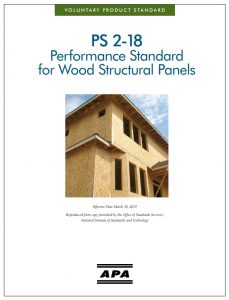PS 2-18 – the US Performance Standard for Wood Structural Panels

PS 2-18 is a performance-based standard establishes structural criteria for assessing the acceptability of plywood, OSB and composite panels for load bearing sheathing applications in construction such as floors, walls and roofs.
It covers performance requirements, adhesive bond requirements, panel construction and workmanship, dimensions and tolerances, marking and moisture content. It also includes test methods to determine compliance. PS 2 defines the requirements for the use of wood-based panels as structural components which are recognized throughout North America.
For the revised PS2-18, click here. As well this Table of Changes in PS 2-18 (June 2019), those most relevant to European specifiers relate to the following updated tables:
- Table 1 adds performance categories 5/16 and 9/16 and gives their panel thickness parameters
- Table 3 now includes the average deflection under load for Wall 16 and Wall 24 span ratings
- Table 4 expands its racking load performance criteria to include Structural 1 Floor as well as Structural 1 Sheathing.
General Requirements: Dimensional tolerances and squareness of the panels, including their performance category and thickness tolerance. The veneer used must be in accordance with the veneer grades and workmanship given in PS 1-09 for plywood.
Performance requirements cover: Adhesive bond performance; structural performance (concentrated and uniform loads, wall racking and fastener holding) and physical properties (dimensional stability, bond performance). Plywood can have a bond classification of either Exterior or Exposure 1, while OSB, composite and mat-formed panels can only have an Exposure 1 classification.
Moisture content: Panels must have a moisture content of less than 16% at the time of shipment and at the time of testing.
Qualification Testing and Mill Specification: Providing test specimen requirements, conformance criteria, and mill specifications.
Qualification Testing: These tests cover structural, physical product properties and adhesive performance within the above ‘Performance Requirements’. Each has its own series of tests for:
Structural use:
- Uniform load
- Concentrated load (static & impact)
- Nail holding
- Racking shear
Product properties:
- Dimensional stability
- Bond performance
Mill Specification: A propriety mill specification is written. once a panel type has passed the qualification testing process, This mill specification is unique to the particular panel type and for that specific mill and must be used for on-going quality assurance procedures. This specification covers:
Mechanical properties:
- Large panel bending stiffness and strength tests
- Small specimen bending stiffness and strength tests
Physical properties:
- Panel grade
- Panel thickness – see Appendix D
- Moisture content
- Linear expansion
Adhesive bond properties:
- Plywood
- OSB
- Composite and mat-formed panels
Test Methods: An outline of the exact test methodology to be followed to determine compliance with the standard. It gives the equipment, specimen preparation and procedure for each specific test as follows:
- Concentrated static and impact load
- Uniform load
- Wall racking load
- Fastener holding resistance
- Large panel bending
- Small static bending for OSB and composite and mat-formed panels
- Linear expansion measured from oven dry or 50% relative humidity to vacuum pressure soak
- Linear expansion and thickness swell measured after wetting one side
- Linear and thickness expansion measured by exposure to relative humidity
- Determination of panel moisture content
- Determination of panel thickness
- Probe test for delamination
- Adhesive mould test
- Adhesive bacteria test
- Moisture cycle test for bond performance
- Moisture cycle test for delamination and strength retention
- Bond performance for plywood with knots and knot holes
- Radial probe test
- Dead weight stiffness (EI)
Trademarking and Certification: Panels conforming to PS 2-18 are obliged to carry the stamp of a qualified inspection and testing agency. This also includes the panel’s grade name in line with its end use application as well as the manufactured nominal thickness; its ‘Performance Category’; span rating; bond classification and the symbol PS 2-18.
For mat-formed panels with orientated strands, these must also carry marks indicating the panel’s strength axis.
APA is the voluntary product standard sponsor and organized the PS 2 Standing Committee that developed the revisions.

